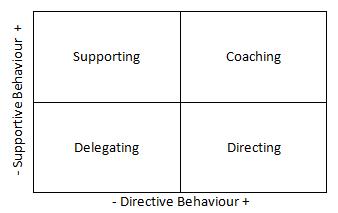
Situational Leadership is a model developed Ken Blanchard and Paul Hersey which suggests that we need to adapt our leadership style to the specifics of each situation and/or follower. Looking at the amount of support behaviour and directive behaviour called for in the situation, it arrives at 4 leadership styles:
- Directing: Leaders define the roles and tasks of the 'follower', and supervise them closely. Decisions are made by the leader and announced, so communication is largely one-way. (Suitable for staff with low competence and low commitment.)
- Delegating: Leaders are still involved in decisions and problem-solving, but control is with the follower. The follower decides when and how the leader will be involved. Read more on delegating. (Suitable for staff with high competence and high commitment.)
- Supporting: Leaders pass day-to-day decisions, such as task allocation and processes, to the follower. The leader facilitates and takes part in decisions, but control is with the follower. (Suitable for staff with high competence and variable commitment.)
- Coaching: Leaders still define roles and tasks, but seeks ideas and suggestions from the follower. Decisions remain the leader's prerogative, but communication is much more two-way. (Suitable for staff with some competence and low commitment.)
 Situational Leadership is a model developed Ken Blanchard and Paul Hersey which suggests that we need to adapt our leadership style to the specifics of each situation and/or follower. Looking at the amount of support behaviour and directive behaviour called for in the situation, it arrives at 4 leadership styles:
Situational Leadership is a model developed Ken Blanchard and Paul Hersey which suggests that we need to adapt our leadership style to the specifics of each situation and/or follower. Looking at the amount of support behaviour and directive behaviour called for in the situation, it arrives at 4 leadership styles:
No comments:
Post a Comment